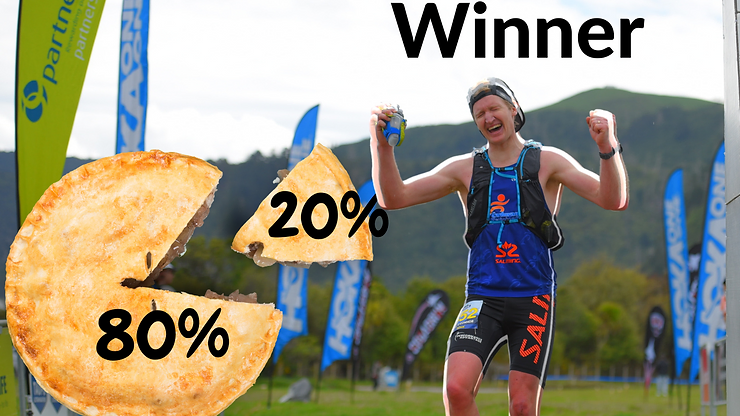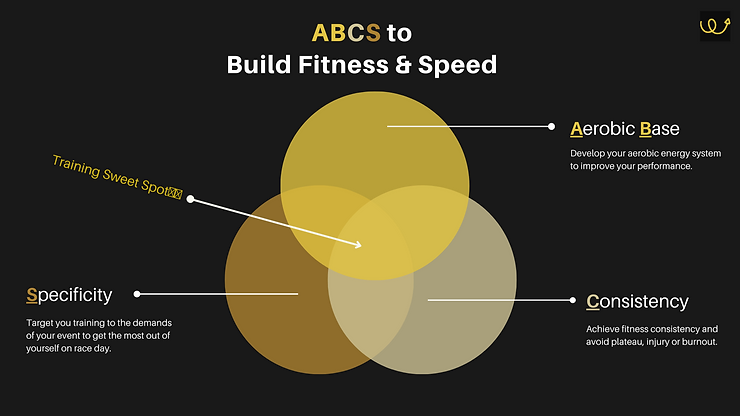Here’s what your running probably looks like;
You mentally sign up for an event but don’t actually sign up because that’s a bit too much commitment upfront.
Start training… without a plan. Or try some free generic plan from Garmin or whoever.
Pretty much ignore the plan and run everything steady because easy running feels like a waste of time and looks lame on Strava.
If you do decide to do some intervals, you smash the first few and then struggle through the last couple or just give up.
You miss a few days of training because you haven’t committed to a training plan to help you plan ahead, so family, work, travel and life fill the spare time you hoped you’d have for running.
All of your training and race paces from 10km – marathon begin to merge into this small bandwidth because you haven’t been training for fitness or speed. You’ve just been sending it when you had the chance.
Race day finally arrives, and you’re totally unsure if you can achieve the arbitrary finish time you’ve chosen for yourself.
After the race, you know you could have run faster, but you’re not really sure how.
Can you relate? Sweet, then sign-up for my running masterclass to optimise your training, and keep reading because polarised training will give your running a massive boost.
Subscribe on Apple, Spotify, Google
80/20 Running
The 80/20 rule suggests that 80% of your training be aerobic in nature, zone 2 or below, and 20% should be anaerobic or ‘hard’, zone 4 and 5. The 80/20 rule is not applied to each training session but should be looked at by ‘time in zone’ over a week or month.
I won’t get into the example here, but I’ll break it down within the podcast and on YouTube.
Why 80/20 polarisation will help your running
You’ve likely been grey zone training, lacking a long-term progress pathway and purpose to your workouts.
When you train in the grey zone, you’re not training for aerobic fitness, and you’re not training for speed. Subsequently, you end up stuck in a rut.
By simply adding clear objectives and boundaries to your training runs, you can begin to break through your training rut and make real progress in your running.
80% of your running needs to be EASY or SLOW. Running slow allows you to build mitochondria and add extra blood vessels (capillarisation) around your muscles which helps build your aerobic base. Best of all, running slowly reduces injury risk and enhances recovery time between runs. Don’t believe me, have a close look at the pro runners you follow on Strava and work out how much slower than their marathon pace they’re running.
20% needs to be fast. Running 80% of your training slowly means you’ll be fresh to run the remaining 20% FAST. I’m talking 10km pace or faster. High-intensity anaerobic training has the compound benefit of maximally stimulating your physiological system and muscular-skeletal system resulting in improved oxygen kinetics, running power, and economy. However, interval training is highly stressful, so we can’t do it all the time. Otherwise, we will end up tired, injured, and right back where we started.
An example week of 80/20 running would be;
1-2x Easy-Aerobic Runs, Zone 1 -2, 30 – 60min
1x Easy-Aerobic Run, Zone 1-2, 60 – 90min
1x Fartlek Run, 2-3x (10x 30-60sec on, 30-60sec off) | 5min between, 10-15min warm up & cool down.
1x VO2max Run, 5-8x 1km @ Zone 5-6 pace/power | 2-3min recovery, 10-20min warm-up & cool down.
Where 80/20 running WON’T work.
Preparation and race phase half marathon & marathon training. I use a six-phase training system broken down into Base 1, 2, 3, Build, Prep, and Race. The prep and race phases typically start 8 weeks out from race day. Half marathons and marathons are run between 90 & 100% of your lactate (anaerobic) threshold. I.e Zone 3 – 4. Within the last two months of your training, you should be doing at least one long race-specific workout, meaning a large amount of your training will be within zone 3. Not fast, not slow, just tempo pace. BUT, as long as your zone 3 training has a specific purpose, it can be productive.
How You Measure Your 80/20 Makes a Big Difference
Heart Rate
Heart rate is often slow to react to changes in intensity, so your heart rate ‘time in zones’ will never accurately reflect your time in zones 4+. For example, your heart rate might take 5min to reach zone 4 during a set of 1min on – 1min off intervals. After 5min, you would have already done 3 reps. That means your heart rate ‘time in zones’ will under-represent your time in Zone 4+. However, if you’re running your easy-aerobic runs too hard, you’ll end up with a big chunk of your training time in zone 3, regardless of your pace or power.
Pace
Pace is mostly good, but if you live in a hilly area or run a lot of trails, your pace will be relatively slow. The same goes for if you’ve been doing a training block with a lot of hill reps. You may put in a zone 4 effort, but your pace will only register as zone 2 or 3 since you’re running relatively slowly uphill. However, you’ll get a solid overview of training distribution on average when all your workouts are considered over a few weeks.
Power
Running power is the best of the lot because it’s not affected by elevation and is relatively accurate on trails when compared to pace. Most watches have natively integrated running power, so ensure you have your threshold and zones set up correctly. https://link.drwillo.com/calculators
You’re Invited to My ABCS to Running PBs Masterclass – LIVE
Optimise your training, eliminate the junk and SMASH your next race. There is no BS, just proven, evidence-back, actionable steps you can immediately use to enhance your run training.
Until next time.
Dr Will
#fasterwithdata
Work with Me
Are you ready to Reignite Your Running in 2023?
Head to https://link.drwillo.com/reigniteyourrunning to apply for my group coaching program that hands intermediate runners the advanced level, personalised and scientifically-backed ‘here’s how you do it’ repeatable runner’s road map, so they can master the workout ‘why,’ consistently increase speed and leap towards their next PB in record time.
Get structure, workouts, and a new PB template for FREE.
You can steal my formula for smashing mind-blowing running PBs in which I outline EXACTLY how you can put together your own structured training plan with event-specific workouts in LESS THAN 10 MINUTES.
DONE-FOR-YOU Training Plans.
Need help building workouts and putting your training plan together? You NEED one of my $59 twelve-week event-specific training plans.
All workouts are locked and loaded. I outline a step-by-step approach for how you can test your threshold, set your zones, and use your data for effective, accountable, confidence-building training. Best of all, my workouts automatically adjust to your threshold and download your watch, so you’re always running at the right intensity.
1-on-1 Accountability & Guidance with Dr Will.
Want me to tell you what to do, check your training, and ensure you smash your goal event? I’d love to help you get to your next finish line with a smile on your face and a PB in your back pocket (and on Strava 😉). Email me to get the conversation started.
Enjoyed this episode?
If you enjoyed this episode and the Running with Dr Will podcast. Please, take two minutes to subscribe, rating and review. You can do that on Apple Podcasts right now by clicking here. If you are an Android user, you can follow the podcast on Google or Spotify. Your reviews will help the podcast reach more runners. Thanks heaps 🙏.




